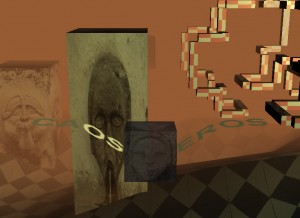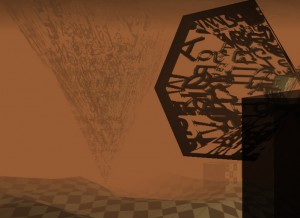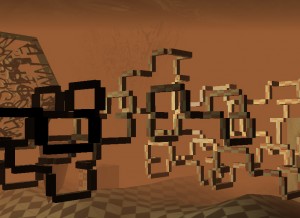 Palavrador is an interactive computer artwork conceived and produced in 2006, during the 38º Winter Festival sponsored by UFMG (Federal University of Minas Gerais, Brazil) in Diamantina (world monument by UNESCO). During 15 days, artists and professors from Brazilian Universities, and abroad used a transdisciplinary methodology to create content that would reflect the complex scenario entwining arts, science and philosophy. At this audiovisual workshop, a proposal for a work created through collective authorship mixing visual arts, literature and music emerged.
Palavrador is an interactive computer artwork conceived and produced in 2006, during the 38º Winter Festival sponsored by UFMG (Federal University of Minas Gerais, Brazil) in Diamantina (world monument by UNESCO). During 15 days, artists and professors from Brazilian Universities, and abroad used a transdisciplinary methodology to create content that would reflect the complex scenario entwining arts, science and philosophy. At this audiovisual workshop, a proposal for a work created through collective authorship mixing visual arts, literature and music emerged.
Such proposal wasn’t thought out in advance. The workshop was beside the official agenda and emerged from the spontaneous and self-organized transdisciplinary activities of the people involved in it. The results and consequences of this group work were bigger than the sum of the parts. This is a typical behavior of a complex system that produces an emergent property since it is an object of creativity on the perspective of art. Palavrador is a collective poetic, integrated, and multifragmented expression which contains diverse world visions. The work received the Digital Poetry Prize of Vinarós city, at Catalunha, in 2006 and was shown at the 2007 Siggraph, in California, USA.
 Palavrador is a poetic cyberworld built in 3D. It uses computational procedures applying artificial life behaviors based on autonomous agents, and computer graphics techniques to create poetic expressions. It was conceived and implemented as a result of synergetic collective assemblage of ideas and activities of the whole group. Authors with background on arts, literature, and computer science worked together in order to conceive and produce a cyber world which has an interface as interactive as games, as dynamic as motion pictures , and as deep as poetic discourse.
Palavrador is a poetic cyberworld built in 3D. It uses computational procedures applying artificial life behaviors based on autonomous agents, and computer graphics techniques to create poetic expressions. It was conceived and implemented as a result of synergetic collective assemblage of ideas and activities of the whole group. Authors with background on arts, literature, and computer science worked together in order to conceive and produce a cyber world which has an interface as interactive as games, as dynamic as motion pictures , and as deep as poetic discourse.
Free from the constraints imposed by written texts, the poetry in Palavrador flies, thus using computer graphics and artificial intelligence to achieve new articulations in its aesthetics structure , unveiling different conceptual possibilities. Poems from several authors were assembled acquiring new formal expressions. Poetic verses constructed as graphics pictures achieved a scenographic dimension, surpassing ornamental characteristics and acquiring strength as interactive actors. Six flocks of meandering poems autonomously wander through the three-dimensional space. The interactors may choose how many flocks of poems they want to see wandering through the environment. The logic of movements was implemented using artificial intelligence procedures based on swarm behavior and steering behaviors of autonomous locomotion agents. The poems (botpoems) are able to turn around obstacles to keep their unveiling cohesion while moving through the space. Among the virtual objects of the Palavrador there is a labyrinth whose architecture is generated by mathematical procedures (fractal). The models that are part of the labyrinth receive texture maps organized through a procedural poetic logic engineered for computational systems. Such logic allows real time actualization of the words and the poems mapped over the faces of the models, changing from time to time, and according to the positions occupied by the avatars.
 There are also video poems scattered through the virtual space. The sound of the spoken poems is modulated according to the distance of the interactors in relation with the audio font, creating an immersive journey with a musical dimension. The interactors may chose between two avatars to represent them inside the virtual environment. One of them flies, and the other one meanders through the space. The dynamic of each avatar shows a variety of poetic connotations. The meandering avatar has a tail formed by seven letters words creating a kinetic poem. Besides that, it is possible to make the avatars “throw up” flying poems by using the joystick. Some of the images used in the scenarios were generated using photos of Diamantina, which is a colonial city. Among those scenarios there are sculptures that decorate fountains of drinkable water scattered through the whole city, ornate floors, and typical details that enrich the colonial architecture. In sum, Palavrador is the verbalization of “palavra”, the Portuguese word for ‘word.’ Palavrador implies action; the creative achievement of words in symbiosis with humans may change our point of view due to concepts that came from the artificial life field. The autonomous poems (bots), that add new perspectives to art and literature, bring ideas from others disciplines like computer science and biology. Therefore, the original concepts will never be the same.
There are also video poems scattered through the virtual space. The sound of the spoken poems is modulated according to the distance of the interactors in relation with the audio font, creating an immersive journey with a musical dimension. The interactors may chose between two avatars to represent them inside the virtual environment. One of them flies, and the other one meanders through the space. The dynamic of each avatar shows a variety of poetic connotations. The meandering avatar has a tail formed by seven letters words creating a kinetic poem. Besides that, it is possible to make the avatars “throw up” flying poems by using the joystick. Some of the images used in the scenarios were generated using photos of Diamantina, which is a colonial city. Among those scenarios there are sculptures that decorate fountains of drinkable water scattered through the whole city, ornate floors, and typical details that enrich the colonial architecture. In sum, Palavrador is the verbalization of “palavra”, the Portuguese word for ‘word.’ Palavrador implies action; the creative achievement of words in symbiosis with humans may change our point of view due to concepts that came from the artificial life field. The autonomous poems (bots), that add new perspectives to art and literature, bring ideas from others disciplines like computer science and biology. Therefore, the original concepts will never be the same.
Palavrador – version 1.5 october 2006
Conception and project direction
Chico Marinho
3D environment
Conception and design: Alckmar Luiz dos Santos, Cristiano Bickel e Tânia Fraga
Animation and modelling: Carlos Augusto Pinheiro de Sousa e Chico Marinho
Procedural animation and poem bots: Gustavo Morais
Image handling: Carlos Augusto Pinheiro de Sousa e Walisson Costa
Poems
Graphic poems: Fernando Aguiar
Poebots: Álvaro Andrade Garcia e Chico Marinho
Poem “Palavra Viva” (audio): Álvaro Andrade Garcia
Poem “Globo da Morte” (audio): Alckmar Luiz dos Santos
Audio
Main track and environment audio: Jalver Bethônico
Sound track of the poem “O Buda da Palavra”: Álvaro Andrade Garcia
Videos
Poem “Palavrador”: Chico Marinho
“Esquadrão Atari” (parts): Daniel Poeira
Images
Photos: Marcelo Kraiser
Software
AI – Collision: Rafael Rodrigues Cacique
AI – swarm behavior: Gustavo Morais
Webcam recognition and interface integration: Leonardo Souza e Lucas Junqueira